Chennai
Appearance
(Redirected from Madras)
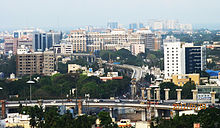
Chennai (formerly Madras) is the capital city of the Indian state of Tamil Nadu. Located on the Coromandel Coast off the Bay of Bengal, it is the biggest industrial and commercial centre in South India, and a major cultural, economic and educational centre. According to the provisional results of 2011 census, the city had 4.68 million residents, making it the sixth most populous city in India.
Quotes
[edit]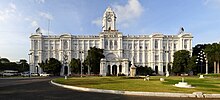
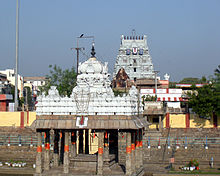


- Sir Josiah Child, one of the directors of the East India Company was responsible for the formation of the Corporation of Chennai, on the model of Dutch Government in the East Indies. On 29th September 1688, the corporation was inaugurated with power to decide petty cases, levy rates upon the inhabitants for building of schools, a town hall and a jail. Nathaniel Higginson was nominated as First mayor with 12 aldermen and 60 burgesses.
- Corporation of Chennai, in "About Corporation of Chennai."
- Over the years, the City has developed in trade, commerce and industry. Chennai City is the biggest industrial and commercial centre of South India. There are about 15,000 industries and factories licensed in the Chennai City.
- Corporation of Chennai, in "About Corporation of Chennai."
- Today, Tamil Nadu has become the largest manufacturing hub, both for electronic hardware, consumer durables and automobiles.
- It (Chennai-Sriperumbudur-Oragadam) is already an automobile hub with so many companies. Its location and access to a sea port is a big plus.
- Spokes person for Hyundai Motors, in "Chennai has emerged as India's Detroit (20 April 2014)."
- Appreciation in the value of the Rupee against the US dollar, interrupted power supply, increased bank rate and labour issues are the reasons cited for the (manufacturing group’s) setback. Becoming a ‘Detroit’ has taken so many years, but staying there seems equally challenging for the State.
- Tamil Nadu Economic Survey Report, in "Chennai has emerged as India's Detroit (20 April 2014)."
- The economic base of Chennai City had shifted from trade and commerce to administration and services by the early part of the 20th Century. In the post-Independence period, manufacturing became an important sector and Commissionerate of Municipal Administration (CMA) continues to be the most important industrial area in the State. Recent trend shows that the economic structure of the City is tertiarised with growing contribution by Information Technology/Information Technology Enabling Service/Business Process Outsourcing Industries.
- Commissionerate of Municipal Administration, in Chapter - III Economy Chapter - III Economy A. Introduction
- Economic development and foreign investment has helped five major Indian cities -- Chennai, New Delhi, Mumbai, Bangalore and Kolkata -- move up on their global rankings in terms of living standards, a latest study shows.
- The Corporation of Chennai (previously Madras) is the Oldest Municipal Institution in India established on the 29th September 1688. A charter was issued on the 30 December 1607 by East Indian Company constituting the "Town of Fort St. George" and all the territories thereunto belonging, not exceeding the distance of ten miles from the Fort, into a Corporation.
A
[edit]- Globalised Chennai is no longer the hamlet-tish Madras of slow days and early nights, quiet avenues and conservative lifestyles. And yet, beneath the gloss lies the old sheen of kapi-tipan [Coffee and Snacks] and Carnatic music.
- Biswajit Balasubramanian and Ranjitha Ashok, in Lots to laugh about (11 April 2005)
- O Lord of Mylapore temple, situated on the shores of the sea with raging waves....
- (One century before the arrival of the Portuguese, Arunagirinathar writes...) Arunagirinathar , quoted in Ishwar Sharan. The Myth of Saint Thomas and the Mylapore Shiva Temple. Third edition. 2010.
C
[edit]- “On their festival days the Hindus would bring their images [to Mylapore beach] accompanied by large crowds and great rejoicing and would, as they approached the door of the church, lower them three times to the ground as a mark of reverence to it, a practice which had been followed from time immemorial.”
- Gaspar Correa, Lendas da India, quoted by George Mark Moraes in A History of Christianity in India, , quoted in Ishwar Sharan. The Myth of Saint Thomas and the Mylapore Shiva Temple. Third edition. 2010.
J
[edit]- "The Lord of Kapaleeswaram sat watching the people of Mylapore – a place full of flowering coconut palms – taking ceremonial bath in the sea on the full moon day of the month of Masai."
- Jnanasambandar. Tirujnanasambandar, in the 6th Poompavai Padikam Thevaram. quoted in Ishwar Sharan. The Myth of Saint Thomas and the Mylapore Shiva Temple. Third edition. 2010.
K
[edit]- "Ptolemy the Greek geographer has referred to Mylapore in his books as 'Maillarpha', a well known seaport town with a flourishing trade. Saint Thiruvalluvar, the celebrated author of Thirukkural, the world famous ethical treatise, lived in Mylapore nearly 2000 years ago. The Shaivite saints of the 7th century, Saint Sambandar and Saint Appar, have sung about this shrine in their hymns. St. Thomas, one of the apostles of Jesus, is reported to have visited Mylapore in the 2nd century (sic) AD. Mylapore fell into the hands of the Portuguese in 1566, when the temple suffered demolition. The present temple was rebuilt about 300 years ago. There are some fragmentary inscriptions from the old temple, still found in the present shrine and in St. Thomas Cathedral."
- From the memorial plaque on the Kapaleeswara Temple, Mylapore, Chennai, quoted in San Thome Cathedral Cover-up Uncovered – G. P. Srinivasan
N
[edit]- “Mylapore, which is a part of Madras city, is an ancient town. Sri Tiruvalluvar, the author of the famous Kural known as Tamil Vedham, who lived in the first century AD, lived his entire life at Mylapore. Saints Sambandar and Appar have composed songs mentioning the God of Mylapore as Shri Kapaleeswara. It was a prosperous town when the English built the Fort St. George in 1593. But the present temple does not contain any feature of the Dravidian style of architecture. The carvings in the pillars are poor specimens compared with those in some of the ancient temples. When there was an erosion of the sea about the close of the last century, there was a landslip on the San Thome beach. It revealed carved stone pillars and broken stones of mandapam found only in Hindu temples. It is a historical fact that the Portuguese, who visited India in the 16th century, had one of their earliest settlements at San Thome, Mylapore. In those days they were very cruel and had iconoclastic tendencies. They razed some Hindu temples to the ground. It is probable that the other Mylapore temple referred to in the Thevaram hymns was built on the seashore and that it was destroyed by the Portuguese about the beginning of the 16th century.”
- P.K. Nambiar, in Census of India 1961, Vol. IX, Part XI, , quoted in Ishwar Sharan. The Myth of Saint Thomas and the Mylapore Shiva Temple. Third edition. 2010.
- A careful study of the monuments and lithic records in Madras reveals a great destruction caused by the Portuguese to Hindu temples in the sixteenth century A.D. The most important temple of Kapaleeswara lost its ancient building during the Portuguese devastation and was originally located near the Santhome cathedral… A few Chola records found in the Santhome cathedral and bishop’s house refer to Kapaleeswara temple and Poompavai. A Chola record in fragment found on the east wall of the Santhome cathedral refers to the image of Lord Nataraja of the Kapaleeswara temple. The temple was moved to the present location in the sixteenth century and was probably built by one Mallappa… A fragmentary inscription, twelfth century Chola record, in the Santhome church region refers to a Jain temple dedicated to Neminathaswami.
- About the Kapaleeswara temple history and controversy of Mylapore, Chennai. Dr. R. Nagaswamy, Director of Archaeology, Tamil Nadu and Director of the Indian Institute of Culture in Madras. ‘Testimony to Religious Ethos’, The Hindu 30 April 1990. Quoted from Goel, S. R. (2016). History of Hindu-Christian encounters, AD 304 to 1996. Chapter 21 [1]
- Dr. R. Nagaswamy, former Director of Archaeology, Tamil Nadu Government, and present Director of the Indian Institute of Culture, Madras, in “Testimony of Religious Ethos”, published in The Hindu, Madras, on 30 April 1990
R
[edit]- One OF the oldest parts of Chennai is Tiru-alli-keni, anglicised as Triplicane, which means the sacred lily tank. The place is named after the large, beautiful tank in front of the temple of Lord Parthasarathy. The beauty of the place, its thick groves, tall mansions and the architecture of the temple have been extolled by Tirumangai Azhwar in a string of 10 verses (padikam). The temple is unique in many ways. It has two main shrines built back-to-back — one facing East (for Lord Parthasarathy) and the other facing West (for Lord Narasimha).
- K. V. Raman, in Unique temple
- The first architectural expansion of the temple took place during the reign of the Pallavas (Tondaiyar Kon) as vividly described by Tirumangai Azhwar. Reminiscent of this is the inscription of the Pallava King Dantivarman (796-847 A.D.), which is preserved in the temple.
- K. V. Raman, in "Unique temple".
- The temple witnessed a major expansion during the rule of the Vijayanagar kings like Sadasiva Raya, Sriranga Raya and Venkatapati Raya II (16th Century). Many sub-shrines and pillared pavilions (mandapas) like the Tiruvaimozhi Mandapa were added.
- K. V. Raman, in "Unique temple".
V
[edit]- Industry-friendly government policies, proximity to the port, a traditional engineering base are factors that have made the City the ‘Auto Hub’ of India.
- M. R. Venkatesh, in "Chennai has emerged as India's Detroit (20 April 2014)."
W
[edit]- M. Arunachalam, in an article in Christianity in India: A Critical Study, is more direct when he writes, “The Kapaleeswara Temple at Mylapore, Madras, is a standing example of Christian desecration. The great temple of Shiva at Mylapore was situated not in its present site, but at the site of the present San Thome Church even up to the end of the 16th century. It was demolished by the Portuguese vandals and their missionaries of that period, who erected their church on the site where the Hindu temple originally stood. “Rama Raya, the Vijayanagar ruler, to save the Hindu temples, waged a war on the Portuguese in Mylapore and Goa simultaneously. The Portuguese were defeated and he took a tribute from them for their vandalism. But, when the Vijayanagar rule fell at the Battle of Talikota (1565) before the Mohammedans, the Portuguese continued their demolition work.” Rama Raya came to Mylapore in 1559, and R.S. Whiteway, in The Rise of Portuguese Power in India, observes that “when San Thome was held to ransom for the intolerant acts of some Jesuits and Franciscans, the Raja of Vijayanagar kept such faith with the Portuguese that, as one of them says, such humanity and justice are not to be found among Christians.”
- M. Arunachalam, R.S. Whiteway,, quoted in Ishwar Sharan. The Myth of Saint Thomas and the Mylapore Shiva Temple. Third edition. 2010.
The Politics of Heritage from Madras to Chennai (29 October 2008)
[edit]Mary E. Hancock The Politics of Heritage from Madras to Chennai (29 October 2008)
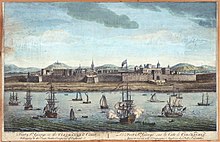
- [Damarla] Venkatapathy sought access to British trade partners, and so granted to the company’s representatives a fishing village, Madraspatnam and surrounding territory. The Fort, built south of Madraspatnam, came to be known to Indians as Chennapatnam, after Venkatapathy’s father, either in deference to the wishes of Damarla Venkatapathy or the site originally bore that name. Chennai Corporation accounts for the use of the name “Madras” over the prior 350 years as the product of “confusion” asserting that the original place names were inexplicably reversed, with Chennai taken to refer to the fishing village and Madras to the fort and environs and that, as a result, historians drew the erroneous conclusion that Madras was the more accurate name.
- Mary E. Hancock, quoting Madars Metropolitan Authority, in p. 227
- Partisan of both “Madras” and “Chennai” used those names to assert that the city was, from its inception, a volatile borderland, a point of contact, mixing, hybridity. For its part “Chennai” suggests the frontier of pre-modern empire, whereas “Madras” is a frontier of modern imperial expansion. Both names, however, assert that the city is a “glocality” – a global entrepot in which diverse population, exchange media, languages, and ideas were brought into intimate and enduring relationships, and, more recently, a product of and staging ground for globalizing capitalism.
- Mary E. Hancock, modified the word ‘glocalisation’, coined by Roland Robertson to capture the articulation of global and local forces in the article “Globalization or Glocalization” published in the Journal of International Commemoration 1, no. 1 (1994):33-53, quoted in pp. 54, 227
- ”Chennai” or variants also appear in descriptive essays and literary works as names for the city that the English know as Madras. The Vishvagunadrasa Campu (composed between 1650 and 1700) and Anandarangavijaya Campu, composed in 1752 refer to the settlement as Chenna Kesava Pura and to “Chenna Patna”, and the Sarva-deva-vilasa uses the term “Cennapuri” or “Cennapuram” as the place name.
- Peterson, in "Eighteenth Century Madras through Indian Eyes", quoted in p. 219
- Critics of the name change favoured the retention of “Madras” and took the incoherence of its spatial form and built environment as their point of departure. Instead of treating these qualities as sins of lack, however, they celebrated them as artifacts of the city’s origins as a colonial port and its status as the ground zero of Indian modernity.
- Mary E. Hancock, in P.54
- There is little doubt that [all of India’s major cities], owe much to the beginnings of modern progress that Madras gave the rest of the subcontinent... Madras, till the 1760s, lay the foundation on which modern India has grown.
- S. Muthiah of Madras Musings on retaining the name of Madras instead of changing it to Chennai, in p. 54
- What emerged [over the eighteenth century]... was not merely a collection of separate quarters, but two or even three distinct societies with their own characteristic ways of organizing space ...the outstanding feature of Madras was that these cultural units – colonial European, indigenous urban and rural societies – in many cases shared the same territory without actually merging together or losing their distinctive characteristic.
- Susan Neild, in p. 217
- A fortuitous collection of villages, separated from the surrounding country by an arbitrary boundary line rather than a town in the usual sense of the word.
- Imperial gazetteer, in 1908 quoted in, p. 217
- Madras, then, is a story of sheer accident changed the future of a fishing village...The fact that Madras is an artificially stimulated growth and not a naturally evolved organism explains why the growth of Madras has been at the expense of the region in which it is set.
- P.V.Venkatakrishnan, in 1971 on the status of Madras City in the regional setting, in p. 217

- Besides the Fort and the Black Town, the city encompassed ten villages acquired by the East India Company from local rulers, several other villages created by Company officials and numerous small hamlets. The population in the early nineteenth century was estimates at 236,500. Half that number resided within Black Town, another thirty thousand in Triplicane, and the remainder in dispersed settlements whose population ranged from a few hundred to several thousand. The 1822 census listed thirty-five villages within Madras, excluding Black Town and hamlets of low caste and “Untouchable” groups, and that 1871 Census identified fifty-eight villages within the Municipal boundary.
- Susan Neild, in p. 218
- Neoclassical architecture was common in Europe by the late eighteenth century and influenced the design of public buildings. This was adopted by Company architects initially in imitation of European fashion but later acquired more intense symbolism meant to distinguish the different origins of rulers and ruled.
- Susan Neild in “Madras”, quoted in p. 218
- The original Black Town was razed in 1758 to allow for an extension of the Fort. This forced residents and businesses to relocate to the adjacent villages Peddanaikenpet and Muthiapet, though the name “Black Town” remained in use.
- Mary E. Hancock, in p. 219
- In 1840s, an organization titled Chennapattnam Hindu Vidya Pareyalochana Sabha (Hindu Council of Education) established Tamil and Telugu schools in various parts of the city.
- Susan Neild in “Madras”, quoted in p. 219
- Black Town’s central temples, Chenna Kesava and Chenna Malleswarar, typify late medieval styles of temple construction in the many sub-shrines, mantapam (pillared-halls) and carved pillars but depart from those styles lacking in Kopuram (entry arches).
- Joanne Waghorne in “The Diaspora of the Gods Hindu in the New world System 1640-1800”, quoted in p. 219


- The British provincial rulers divested the Nawab of his title and his jurisdictional authority following the Company’s defeat of Tippu and its annexation of his Caranatic holdings. The Nawab and his descendants were granted a title (The Prince of Arcot) and pension, and a portion of the estate was allocated for their use. The estate’s main palace, the Chepauk Palace, was purchased by the British administration in 1855 and converted to government offices, and it continues to be used in this way.
- Susan Neild in “Madras”, quoted in p. 219
- Early leadership of the Indian National Congress, and its forerunner, the Hindu Mahajana Sabha, was based in Madras and the city had hosted early meetings of these organizations. The high-caste residents of Madras were also prominently represented in the Home Rule League, a Gandhian organization with strong ties to the Theosophical Society, Headquartered on an estate in Adyar, about 9 km south of the city’s urban core.
- D. Sadasivan in “The Growth of Public opinion in Madras Presdiency”, quoted in, p. 220
- The Imperial Gazetteer of India reported the intensification of the urban character of Madras in the early twentieth century, noting that 30 percent of the city’s population was between the ages of twenty and forty and that the sex ratio was 98/100.
- Mary E. Hancock, in p. 220
- The population of the city, as reported in the 1871 Census, was 367,552; in 1881, 405,848; in 1891, 452,518; in 1901, 509, 346; in 1911, 518,660; in 1921, 526,912; and in 1931, 647,230.
- Mary E. Hancock, in p. 220
- The Tamil Film Industry’s history is summarized in “Cinema of the Urban Poor in South India”. The first production studios were set up in 1920s and 1930s; with the advent of sound, regional cinema (i.e, those in languages other than Hindi or English) quickly gained in popularity. The first theaters were built in the 1910s on Mount Road, in Georgetown and Purasalwakam. By 1927 the city had nine theatres; in 1941 that number had risen to twenty.
- Mary E. Hancock, in p. 220
- By the first decade of the twentieth century, 125 newspapers and periodicals existed in the Presidency, of the total, 65 were under vernacular (Tamil, Telugu or Hindi) or bilingual publications. The city itself had 5 daily newspapers at that point, all English language; 3 (The Hindu, The Madras Standard, and The Indian Patriot) were published and edited by Indians.
- Mary E. Hancock, in p. 220 quoting from the Imperial Gazetteer of India/
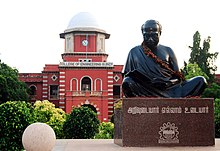
- Neoclassical details abounded in the statues of colonial officers and British royals that appeared during the course of the nineteenth century, in public buildings, in the city’s new parks, and along the major roadways. These began to appear at junctions in the city in 1839 and later in parks and on the grounds of the government buildings. In 1898, the Madras Government Press listed ten statues in the city, all having been erected by the colonial government. The 1908 Imperial Gazetteer noted that a statue dedicated to an Indian High Court Justice, Muttuswami Ayyer, was added to the list. It was not until after independence, however, that additional statues commemorating Indian cultural heroes and political leaders appeared in public places.
- Mary E. Hancock, in p. 220
- By the late 1930s all nationalist movements had generated historolographical writing. Poetry, essays, plays, and fiction, as well as aural and visual representations (maps, cartoons, lithographs, sculpture, songs, film); all were generative of politically infused historical consciousness.
- S.P.Sen in Historians and Histiriography, quoted by Mary E. Hancock, in p. 223
- In the 1937 provincial elections, nationalist associated with the Indian National Congress had gained a legislative foothold and C. Rajagopalachari, a lawyer and Congress nationalist, was the presidency's premier between 1937 and 1939. In an effort to advance the pan-Indian nationalist cause, he had introduced legislation making study of Hindi compulsory in the Presidency’s secondary schools. In the course of protests, twelve hundred persons were incarcerated, and in 1939, two men died in prison. They were hailed as martyrs and mourned with elaborate funeral processions in Madras. Their sentiment was encapsulated in poems such as this: [Our] mind is Tamil; [Our] entire body is Tamil; [Our] life is Tamil; [Our] pulse is Tamil; [Our] veins are Tamil; [Our] flesh, muscle, everything is Tamil; everything in [our] body is Tamil, Tamil, Tamil.
- Mary E. Hancock, quoting Ramaswamy in “Passions of the Tongue”, in p. 223
- After Mumbai, Chennai is India’s second most populous destination for investment. During the 1990s, domestic, foreign, and multinational corporations...opened production sites and offices in or outside Chennai.
- Mary E. Hancock, quoting N. Bajpai and N.Radjou in “Raising the Global Competitiveness of tamilnadu’s Information Technology Industry ”, in p. 224
- Chennai also has a large and growing services sector, accounting for over 40 percent of the total organized sector employment.
- Mary E. Hancock, quoting Madars Metropolitan Authority, in p. 224
- The Madras Atomic Power Station (MAPS) is a comprehensive nuclear power production, fuel reprocessing, and waste treatment facility that includes plutonium fuel fabrication for fast breeder reactors. Commercial operations at MAPS started in 1983.
- Mary E. Hancock, in p. 246
- That aroused my curiosity and I started reading more about the city and its origins and realized that the foundation for modern India was laid in Madras... it all started here.
- S. Muthiah, when in 1971-72, the first map of Madras was printed Muthiah had written the text for the guide and in that process had discovered that Clive, Hastings, Wellington and Yale had started their careers in Madras. Quoted in “Crusader for Chennai (11 March 2002)”
Trade and Politics on the Coromandel Coast: Seventeenth and Early Eighteenth …
[edit]
Trade and Politics on the Coromandel Coast: Seventeenth and Early Eighteenth … (2012)
- Constant efforts were made to attract merchants to settle at Madras. In 1688, an agreement was signed between the Armenians and the East India Company at London the right to trade to and from any of the ports to which the English traded, or where the English had a settlement, on the same terms that the English enjoyed.
- Radhika Seshan, in p. 95
- The Armenians had begun to settle in Madras even earlier, for they were reported to have made Madras their permanent base on the Corommandel Coast from 1666. They had been trading along the coast since the sixteenth century, and claimed to have directed the Portuguese to Saint Thome.
- Mesrovb Jacob Seth, in p. 95
- Before long the Armenians were the richest inhabitants of Madras.
- Radhika Seshan, in p. 95
Diaspora of the Gods : Modern Hindu Temples in an Urban Middle-Class World
[edit]

Joanne Punzo Waghorne, Diaspora of the Gods : Modern Hindu Temples in an Urban Middle-Class World … (19 August 2004)
- Almost every book on the city begins with “Madras is a city of Villages”...Madras in 1995 still had a village feel. Within its bounds are former villages swamped by the city tide as well as ancient once-independent towns like Mylapore, Triplicane, Tiruvanmayur, and nearby Tiruvottiyur.
- Joanne Punzo Waghorne, in P.46
- The East India Company acquired control over the land that would become the city of Madras, piecemeal over 150 years. Fort St. George and the old Black Town –Muthialpet acquired in 1640 were expanded over thirty years for most of what is now Georgetown. The important town of Triplicane saw British control by the 1670s, and the towns of Egmore, Chetput, Pursalwalkam, and Kilpauk by the 1690s. the Company annexed Mylapore in 1749. By 1798, when the map ‘Limits of Madras as Fixed on 2 November 1789” was issued, Madaras acquired its modern outline. The city stayed “fixed” for well over a century. The only addition came in 1923, when the zamindari of Mambalam was ceded to Madras, and in 1946, and 1981, when the borders of the city were extended.
- George Kuriyan, in Growth of the City of Madras, in p. 47
- Although “Madraspatnam” emerged as a new political entity, some of the towns and villages encased by its limits had genealogies extending into the Greco-Roman period, and other had monuments to authenticate claims of Pallava (650-1100) and Chola (850-1350) rule.
- K.V.Raman, in "The early History of Madras region", quoted in p. 47
- In all cases, the relatively recent rule of Muslim chiefs and the newly emerged Nawab of the Arcot left a late but indelible imprint of Islamic influence within the city.
- S. Bayly, in p. 47
- The Portuguese from their old fort city in Mylapore built the legend of San Thome de Meliyapor and a strong Roman Catholic presence into the city.
- S. Muthiah, in p. 47
- Armenian merchants who came to this growing center of trade built one of the oldest extant Christian churches in the city and once had a strong presence there.
- In p. 47
- Madras is not now nor ever has been a “temple city”. Unlike Madurai or nearby Kanchipuram, its center, even now remains Fort St. George, the old commercial headquarters of the East India Company–arguably the first of the modern global corporations. But Madras has over six hundred temples now, and had many in the past.
- In P.52
- The Town Temple was the company’s Pagoda and most probably the management of the temple was at one time vested in the Company...a high percentage of the tolls collected in the city for the maintenance and upkeep of temples and choultries were devoted to the expenses of the Town Temple.
- Ramachandra Dikhitar, in p. 57
- In 1757, the Company razed the temple and with it much of the old Black Town to create a buffer zone and stronger fortifications around Fort St. George, in an era when British power was continually challenged by the French. The company, however, took great pains to offer new land as well as monetary compensation, so that the local merchants could raise a new temple, which was constructed in 1766 and still stands....The rebuilt Town Temple actually contains two temples side by side with a modest door between them. The Chenna Keshava Perumal Temple continues the name of the old Town Temple. Added to this on the same plot is the Chennamallikeswara Temple. Both the forms of Vishnu as Kesava Perumal and Shiva as Mallikeshwara are generic names of the gods....the name of Chenna/i in both names normally derives from the Tamil name of the city, and now the official name for Madras.
- Joanne Punzo Waghornep, in pp.57-58


